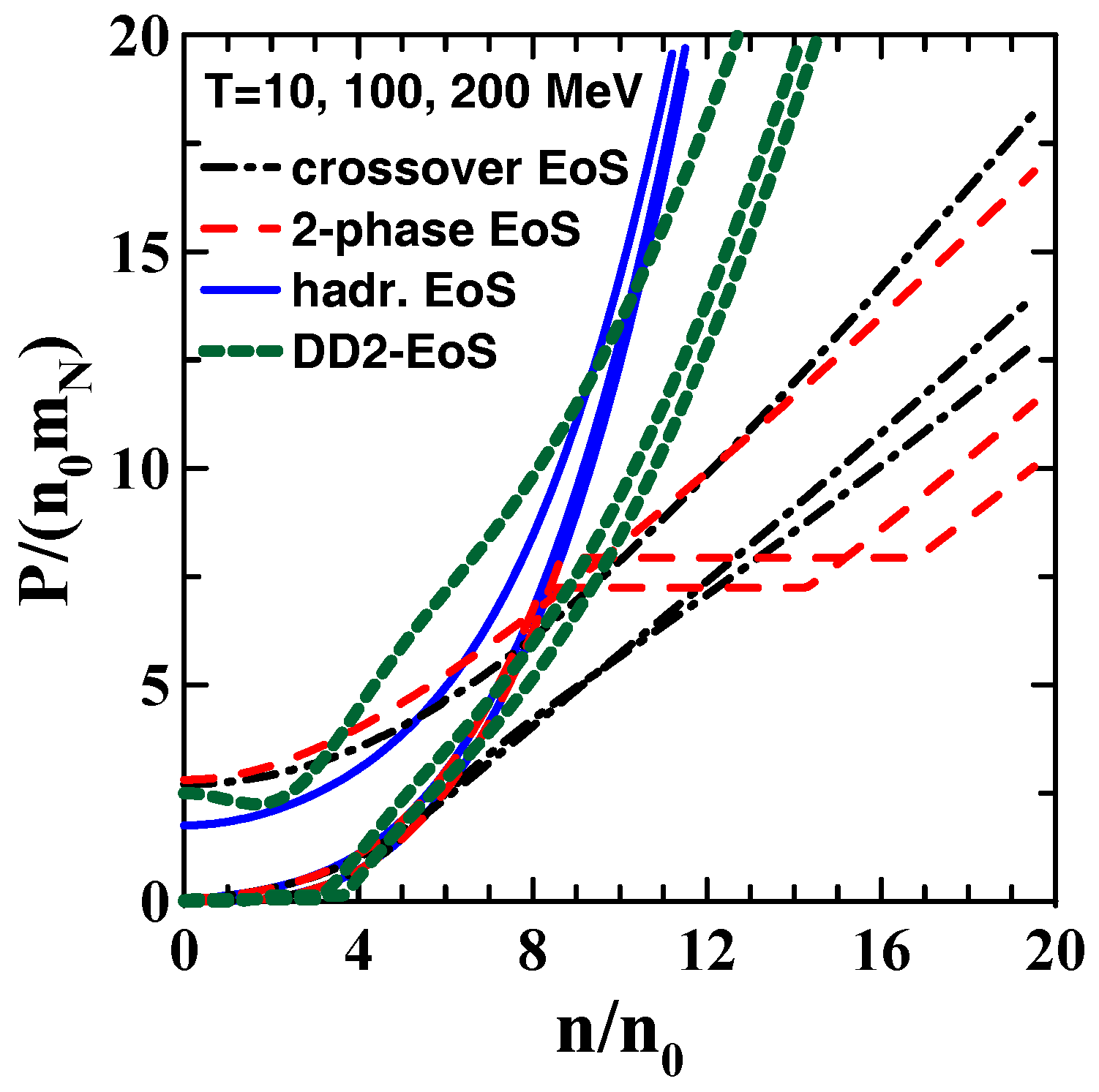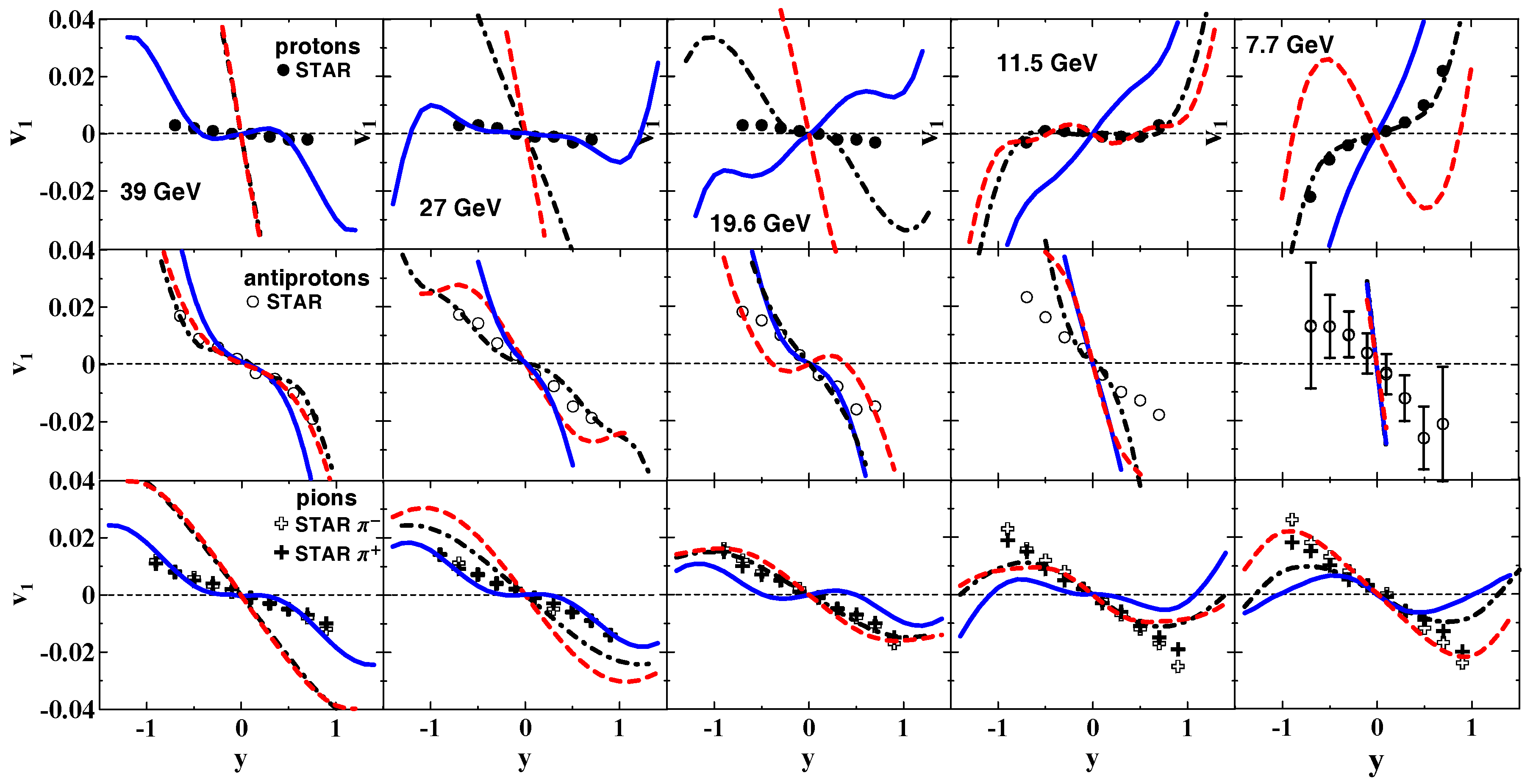Directed Flow in Heavy-Ion Collisions and Its Implications for Astrophysics
Abstract
:1. Introduction
2. The 3FD Model
3. Results
4. Conclusions
Acknowledgments
Conflicts of Interest
References
- Danielewicz, P.; Odyniec, G. Transverse Momentum Analysis of Collective Motion in Relativistic Nuclear Collisions. Phys. Lett. B 1985, 157, 146–150. [Google Scholar] [CrossRef]
- Voloshin, S.; Zhang, Y. Flow study in relativistic nuclear collisions by Fourier expansion of Azimuthal particle distributions. Z. Phys. C 1996, 70, 665–671. [Google Scholar] [CrossRef]
- Voloshin, S.A.; Poskanzer, A.M.; Snellings, R. Collective phenomena in non-central nuclear collisions. In Relativistic Heavy Ion Physics; Landolt-Börnstein—Group I Elementary Particles, Nuclei and Atoms; Springer-Verlag: New York, NY, USA, 2010. [Google Scholar]
- Sorge, H. Elliptical flow: A signature for early pressure in ultrarelativistic nucleus-nucleus collisions. Phys. Rev. Lett. 1997, 78, 2309–2312. [Google Scholar] [CrossRef]
- Herrmann, N.; Wessels, J.P.; Wienold, T. Collective flow in heavy ion collisions. Ann. Rev. Nucl. Part. Sci. 1999, 49, 581–632. [Google Scholar] [CrossRef]
- Russkikh, V.N.; Ivanov, Y.B. Collective flow in heavy-ion collisions for Elab = 1 × 160 GeV/nucleon. Phys. Rev. C 2006, 74, 034904. [Google Scholar] [CrossRef]
- Hung, C.M.; Shuryak, E.V. Hydrodynamics near the QCD phase transition: Looking for the longest lived fireball. Phys. Rev. Lett. 1995, 75, 4003–4006. [Google Scholar] [CrossRef] [PubMed]
- Rischke, D.H.; Pursun, Y.; Maruhn, J.A.; Stöcker, H.; Greiner, W. The phase transition to the quark-gluon plasma and its effects on hydrodynamic flow. Heavy Ion Phys. 1995, 1, 309–322. [Google Scholar]
- Rischke, D.H. Hydrodynamics and collective behaviour in relativistic nuclear collisions. Nucl. Phys. A 1996, 610, 88–101. [Google Scholar] [CrossRef]
- Csernai, L.P.; Rohrich, D. Third flow component as QGP signal. Phys. Lett. B 1999, 458, 454–459. [Google Scholar] [CrossRef]
- Brachmann, J.; Soff, S.; Dumitru, A.; Stöcker, H.; Maruhn, J.A.; Greiner, W.; Rischke, D.H. Antiflow of nucleons at the softest point of the equation of state. Phys. Rev. C 2000, 61, 024909. [Google Scholar] [CrossRef]
- Stöcker, H. Collective flow signals the quark-gluon plasma. Nucl. Phys. A 2005, 750, 121–147. [Google Scholar] [CrossRef]
- Snellings, R.J.M.; Sorge, H.; Voloshin, S.A.; Wang, F.Q.; Xu, N. Novel rapidity dependence of directed flow in high energy heavy ion collisions. Phys. Rev. Lett. 2000, 84, 2803–2805. [Google Scholar] [CrossRef] [PubMed]
- Adamczyk, L.; Adkins, J.K.; Agakishiev, G.; Aggarwal, M.M.; Ahammed, Z.; Alekseev, I.; Alford, J.; Anson, C.D.; Aparin, A.; Arkhipkin, D.; et al. Beam-Energy Dependence of Directed Flow of Protons, Antiprotons and Pions in Au+Au Collisions. Phys. Rev. Lett. 2014, 112, 162301. [Google Scholar] [CrossRef] [PubMed]
- Steinheimer, J.; Auvinen, J.; Petersen, H.; Bleicher, M.; Stöcker, H. Examination of directed flow as a signal for a phase transition in relativistic nuclear collisions. Phys. Rev. C 2014, 89, 054913. [Google Scholar] [CrossRef]
- Konchakovski, V.; Cassing, W.; Ivanov, Y.; Toneev, V. Examination of the directed flow puzzle in heavy-ion collisions. Phys. Rev. C 2014, 90, 014903. [Google Scholar] [CrossRef]
- Ivanov, Y.B.; Soldatov, A.A. Directed flow indicates a cross-over deconfinement transition in relativistic nuclear collisions. Phys. Rev. C 2015, 91, 024915. [Google Scholar] [CrossRef]
- Ivanov, Y.B.; Soldatov, A.A. What can we learn from the directed flow in heavy-ion collisions at BES RHIC energies? Eur. Phys. J. A 2016, 52, 10. [Google Scholar] [CrossRef]
- Nara, Y.; Ohnishi, A. Does non-monotonic behavior of directed flow signal the onset of deconfinement? Nucl. Phys. A 2016, 956, 284–287. [Google Scholar] [CrossRef]
- Nara, Y.; Niemi, H.; Ohnishi, A.; Stöcker, H. Examination of directed flow as a signature of the softest point of the equation of state in QCD matter. Phys. Rev. C 2016, 94, 034906. [Google Scholar] [CrossRef]
- Nara, Y.; Niemi, H.; Steinheimer, J.; Stöcker, H. Equation of state dependence of directed flow in a microscopic transport model. Phys. Lett. B 2017, 769, 543–548. [Google Scholar] [CrossRef]
- Singha, S.; Shanmuganathan, P.; Keane, D. The first moment of azimuthal anisotropy in nuclear collisions from AGS to LHC energies. Adv. High Energy Phys. 2016, 2016, 2836989. [Google Scholar] [CrossRef]
- Petersen, H.; Steinheimer, J.; Burau, G.; Bleicher, M.; Stöcker, H. A Fully Integrated Transport Approach to Heavy Ion Reactions with an Intermediate Hydrodynamic Stage. Phys. Rev. C 2008, 78, 044901. [Google Scholar] [CrossRef]
- Bass, S.; Belkacem, M.; Bleicher, M.; Brandstetter, M.; Bravina, L.; Ernst, C.; Gerland, L.; Hofmann, M.; Hofmann, S.; Konopka, J.; et al. Progress in Particle and Nuclear Physics. Prog. Part. Nucl. Phys. 1998, 41, 255–369. [Google Scholar] [CrossRef]
- Cassing, W.; Bratkovskaya, E.L. Parton–hadron–string dynamics: An off-shell transport approach for relativistic energies. Nucl. Phys. A 2009, 831, 215–242. [Google Scholar] [CrossRef]
- Cassing, W.; Bratkovskaya, E.L. Hadronic and electromagnetic probes of hot and dense nuclear matter. Phys. Rep. 1999, 308, 65–233. [Google Scholar] [CrossRef]
- Ivanov, Y.B.; Russkikh, V.N.; Toneev, V.D. Relativistic heavy-ion collisions within three-fluid hydrodynamics: Hadronic scenario. Phys. Rev. C 2006, 73, 044904. [Google Scholar] [CrossRef]
- Ivanov, Y.B. Alternative Scenarios of Relativistic Heavy-Ion Collisions: I. Baryon Stopping. Phys. Rev. C 2013, 87, 064904. [Google Scholar] [CrossRef]
- Russkikh, V.N.; Ivanov, Y.B. Vorticity in heavy-ion collisions at the JINR Nuclotron-based Ion Collider fAcility. Phys. Rev. C 2007, 76, 054907. [Google Scholar] [CrossRef]
- Ivanov, Y.B.; Russkikh, V.N. On freeze-out problem in relativistic hydrodynamics. Phys. Atomic Nucl. 2009, 72, 1238–1244. [Google Scholar] [CrossRef]
- Galitsky, V.M.; Mishustin, I.N. Relativistic effects in collision of heavy ions. Sov. J. Nucl. Phys. 1979, 29, 363–373. (In Russian) [Google Scholar]
- Khvorostukhin, A.S.; Skokov, V.V.; Redlich, K.; Toneev, V.D.; Redlich, K. Lattice QCD constraints on the nuclear equation of state. Eur. Phys. J. C 2006, 48, 531–543. [Google Scholar] [CrossRef]
- Klähn, T.; Łastowiecki, R.; Blaschke, D.B. Implications of the measurement of pulsars with two solar masses for quark matter in compact stars and heavy-ion collisions: A Nambu Jona-Lasinio model case study. Phys. Rev. D 2013, 88, 085001. [Google Scholar] [CrossRef]
- Typel, S.; Ropke, G.; Klahn, T.; Blaschke, D.; Wolter, H.H. Composition and thermodynamics of nuclear matter with light clusters. Phys. Rev. C 2010, 81, 015803. [Google Scholar] [CrossRef]
- Ivanov, Y.B. Alternative Scenarios of Relativistic Heavy-Ion Collisions: II. Particle Production. Phys. Rev. C 2013, 87, 064905. [Google Scholar] [CrossRef]
- Ivanov, Y.B. Alternative Scenarios of Relativistic Heavy-Ion Collisions: III. Transverse Momentum Spectra. Phys. Rev. C 2014, 89, 024903. [Google Scholar] [CrossRef]
- Ivanov, Y.B. Baryon Stopping as a Probe of Deconfinement Onset in Relativistic Heavy-Ion Collisions. Phys. Lett. B 2013, 721, 123–130. [Google Scholar] [CrossRef]
- Ivanov, Y.B. Phase Evolution and Freeze-out within Alternative Scenarios of Relativistic Heavy-Ion Collisions. Phys. Lett. B 2013, 726, 422–426. [Google Scholar] [CrossRef]
- Ivanov, Y.B. Elliptic Flow of Protons and Antiprotons in Au+Au Collisions at = 7.7–62.4 GeV within Alternative Scenarios of Three-Fluid Dynamics. Phys. Lett. B 2013, 723, 475–480. [Google Scholar] [CrossRef]
- Ivanov, Y.B.; Soldatov, A.A. Elliptic Flow in Heavy-Ion Collisions at Energies = 2.7–39 GeV. Phys. Rev. C 2015, 91, 024914. [Google Scholar] [CrossRef]
- Hamieh, S.; Redlich, K.; Tounsi, A. Canonical description of strangeness enhancement from p-A to Pb Pb collisions. Phys. Lett. B 2000, 486, 61–66. [Google Scholar] [CrossRef]
- Alford, M.; Braby, M.; Paris, M.W.; Reddy, S. Hybrid stars that masquerade as neutron stars. Astrophys. J. 2005, 629, 969–978. [Google Scholar] [CrossRef]
- Demorest, P.; Pennucci, T.; Ransom, S.; Roberts, M.; Hessels, J. Shapiro Delay Measurement of A Two Solar Mass Neutron Star. Nature 2010, 467, 1081–1083. [Google Scholar] [CrossRef] [PubMed]
- Antoniadis, J.; Freire, P.C.C.; Wex, N.; Tauris, T.M.; Lynch, R.S.; van Kerkwijk, M.H.; Kramer, M.; Bassa, C. A Massive Pulsar in a Compact Relativistic Binary. Science 2013, 340, 1233232. [Google Scholar] [CrossRef] [PubMed]
- Ajitanand, N.N.; Alexander, J.; Anderson, M.; Best, D.; Brady, F.P.; Case, T.; Caskey, W.; Cebra, D.; Chance, J.; Cole, B. Sideward Flow in Au+Au Collisions between 2A and 8A GeV. Phys. Rev. Lett. 2000, 84, 5488. [Google Scholar]
- Alt, C.; Anticic, T.; Baatar, B.; Barna, D.; Bartke, J.; Behler, M.; Betev, L.; Bialkowska, H.; Billmeier, A.; Blume, C.; et al. Directed and elliptic flow of charged pions and protons in Pb + Pb collisions at 40 A and 158 A GeV. Phys. Rev. C 2003, 68, 034903. [Google Scholar] [CrossRef]
- Ivanov, Y.B.; Soldatov, A.A. Directed flow is a sensitive probe of deconfinement transition. Eur. Phys. J. A 2016, 52, 246. [Google Scholar] [CrossRef]
- Batyuk, P.; Blaschke, D.; Bleicher, M.; Ivanov, Y.B.; Karpenko, I.; Merts, S.; Nahrgang, M.; Petersen, H.; Rogachevsky, O. Event simulation based on three-fluid hydrodynamics for collisions at energies available at the Dubna Nuclotron-based Ion Collider Facility and at the Facility for Antiproton and Ion Research in Darmstadt. Phys. Rev. C 2016, 94, 044917. [Google Scholar] [CrossRef]
- Aoki, Y.; Endrodi, G.; Fodor, Z.; Katz, S.D.; Szabo, K.K. The Order of the quantum chromodynamics transition predicted by the standard model of particle physics. Nature 2006, 443, 675–678. [Google Scholar] [CrossRef] [PubMed]


© 2017 by the author. Licensee MDPI, Basel, Switzerland. This article is an open access article distributed under the terms and conditions of the Creative Commons Attribution (CC BY) license (http://creativecommons.org/licenses/by/4.0/).
Share and Cite
Ivanov, Y.B. Directed Flow in Heavy-Ion Collisions and Its Implications for Astrophysics. Universe 2017, 3, 79. https://doi.org/10.3390/universe3040079
Ivanov YB. Directed Flow in Heavy-Ion Collisions and Its Implications for Astrophysics. Universe. 2017; 3(4):79. https://doi.org/10.3390/universe3040079
Chicago/Turabian StyleIvanov, Yuri B. 2017. "Directed Flow in Heavy-Ion Collisions and Its Implications for Astrophysics" Universe 3, no. 4: 79. https://doi.org/10.3390/universe3040079
APA StyleIvanov, Y. B. (2017). Directed Flow in Heavy-Ion Collisions and Its Implications for Astrophysics. Universe, 3(4), 79. https://doi.org/10.3390/universe3040079




